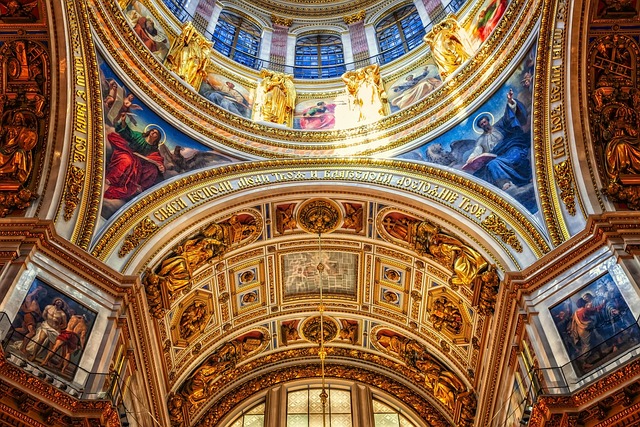Orthodox Christians celebrate Christmas as one of the most significant religious holidays. The celebration follows the Julian calendar, which places Christmas on January 7th. This festive occasion is marked by various religious rituals, including church services, fasting, and the exchange of greetings and gifts. Orthodox Christians also engage in traditional customs and practices that vary across different regions and cultures. Overall, Christmas holds great spiritual and cultural importance for Orthodox Christians worldwide.
Table of Contents
Traditional Orthodox Christmas Customs and Traditions
Orthodox Christians around the world celebrate Christmas with a rich tapestry of customs and traditions that have been passed down through generations. These traditions vary from country to country, but they all share a common thread of faith and reverence for the birth of Jesus Christ.
One of the most prominent customs is the observance of a 40-day Advent period leading up to Christmas. This period of fasting and prayer is a time of spiritual preparation for the celebration of Christ’s birth. During this time, Orthodox Christians abstain from meat, dairy, and other animal products, focusing instead on a diet of fruits, vegetables, and grains. This period of fasting is seen as a way to purify the body and soul, making it ready to receive the joy of Christmas.
On Christmas Eve, Orthodox Christians gather in their local churches for a special midnight liturgy. The atmosphere is filled with anticipation and excitement as the faithful come together to celebrate the birth of Christ. The liturgy is a beautiful and solemn service, with prayers, hymns, and readings from the Bible. The highlight of the service is the moment when the priest announces the birth of Christ, and the congregation responds with joyous hymns and prayers.
After the liturgy, families return home to enjoy a festive meal together. Traditional dishes vary from country to country, but some common favorites include roasted meats, fish, and a variety of delicious desserts. In many Orthodox Christian homes, it is customary to set an extra place at the table for any unexpected guests who may arrive. This gesture symbolizes the hospitality and generosity that are central to the Christmas spirit.
Another cherished tradition is the exchange of gifts. In many Orthodox Christian communities, gifts are not exchanged on Christmas Day itself, but rather on January 6th, which is known as Epiphany or Theophany. This day commemorates the baptism of Jesus in the Jordan River and is considered a significant event in the life of Christ. On this day, families gather together to exchange gifts and share in the joy of the season.
In addition to these customs, Orthodox Christians also engage in various cultural traditions that are unique to their respective countries. For example, in Greece, it is common to decorate a small boat instead of a Christmas tree, symbolizing the importance of the sea in Greek culture. In Russia, it is customary to visit loved ones’ graves on Christmas Day and leave small gifts as a way of honoring their memory.
Overall, Orthodox Christians celebrate Christmas with a deep sense of reverence and joy. The customs and traditions that are observed during this time reflect the rich history and cultural diversity of the Orthodox Christian faith. Whether it is through fasting, attending midnight liturgies, or exchanging gifts, Orthodox Christians come together to honor the birth of Jesus Christ and to share in the love and peace that this season brings.
The Significance of the Nativity Fast in Orthodox Christmas Celebrations

Orthodox Christians around the world celebrate Christmas in a unique and meaningful way. One of the most important aspects of their Christmas celebrations is the Nativity Fast, which holds great significance in their religious calendar. This period of fasting and preparation helps Orthodox Christians to spiritually prepare for the birth of Jesus Christ.
The Nativity Fast, also known as Advent, begins on November 15th and lasts for forty days, leading up to Christmas. During this time, Orthodox Christians abstain from certain foods, such as meat, dairy products, and sometimes even oil and wine. The purpose of this fast is to focus on prayer, repentance, and self-discipline, as well as to remind believers of the humble conditions in which Jesus was born.
The Nativity Fast is not just about abstaining from certain foods; it is also a time for increased prayer and reflection. Orthodox Christians attend church services more frequently during this period, participating in special prayers and liturgies that are specific to the Nativity Fast. These services help believers to deepen their spiritual connection with God and prepare their hearts for the joyous celebration of Christmas.
In addition to fasting and increased prayer, the Nativity Fast also encourages acts of charity and giving. Orthodox Christians are encouraged to be more generous during this time, reaching out to those in need and sharing their blessings with others. This emphasis on giving reflects the spirit of Christmas and reminds believers of the importance of selflessness and compassion.
The Nativity Fast is not just a personal journey; it is a communal experience for Orthodox Christians. Families and communities come together to support one another during this time, sharing meals that are in accordance with the fasting guidelines. This sense of unity and solidarity strengthens the bonds between believers and reinforces the importance of community in their faith.
As the Nativity Fast comes to an end, Orthodox Christians eagerly anticipate the arrival of Christmas. The fast is broken with a festive meal on Christmas Eve, known as the Holy Supper. This meal typically includes twelve dishes, symbolizing the twelve apostles, and is shared with family and loved ones. It is a time of joy and celebration, as believers gather to commemorate the birth of Jesus Christ.
The Nativity Fast holds great significance in Orthodox Christmas celebrations. It is a time of spiritual preparation, self-discipline, and increased prayer. Through fasting, prayer, and acts of charity, Orthodox Christians seek to deepen their connection with God and reflect on the humble conditions in which Jesus was born. The Nativity Fast also fosters a sense of community and togetherness, as families and communities come together to support one another. As the fast comes to an end, the joyous celebration of Christmas begins, with the Holy Supper marking the start of the festivities. Orthodox Christians truly embrace the spirit of Christmas through their observance of the Nativity Fast.
Iconography and Symbolism in Orthodox Christmas Worship
Orthodox Christians have a rich and vibrant tradition when it comes to celebrating Christmas. One aspect that sets their celebrations apart is the use of iconography and symbolism in their worship. These visual representations play a significant role in Orthodox Christmas worship, adding depth and meaning to the festivities.
Iconography, the art of creating religious images, holds a special place in Orthodox Christianity. Icons are not mere decorations; they are considered windows into the divine. In Orthodox Christmas worship, icons depicting the Nativity scene are prominently displayed in churches and homes. These icons serve as a visual reminder of the birth of Jesus and the significance of this event in the Christian faith.
The symbolism within these icons is carefully crafted to convey specific theological messages. For example, the icon of the Nativity often includes the presence of animals, such as an ox and a donkey. This inclusion is not accidental; it is a reference to the prophecy in the Old Testament that states, “The ox knows its owner, and the donkey its master’s crib” (Isaiah 1:3). By including these animals, the icon emphasizes the fulfillment of ancient prophecies and the recognition of Jesus as the long-awaited Messiah.
Another important symbol in Orthodox Christmas worship is the star. The star of Bethlehem, which guided the wise men to the birthplace of Jesus, is a powerful symbol of divine guidance and revelation. In icons, the star is often depicted shining brightly above the manger, illuminating the scene and drawing attention to the central figure of Christ. This symbol reminds believers of the light that Jesus brings into the world and the guidance he offers to those who seek him.
In addition to icons, Orthodox Christians also incorporate symbolism into their liturgical practices during Christmas. For example, the use of incense is a common practice in Orthodox worship. The rising smoke symbolizes the prayers of the faithful ascending to heaven, creating a connection between the earthly and the divine. During Christmas services, the sweet aroma of incense fills the air, creating a sensory experience that enhances the worship experience.
Candles are another important symbol in Orthodox Christmas worship. The lighting of candles represents the light of Christ entering the world and dispelling darkness. Orthodox Christians often hold candles during Christmas services, creating a warm and inviting atmosphere that reflects the joy and hope of the season.
The use of iconography and symbolism in Orthodox Christmas worship serves as a powerful reminder of the central message of Christmas: the incarnation of Jesus Christ. These visual representations help believers connect with the story of Christ’s birth on a deeper level, allowing them to experience the wonder and awe of this miraculous event.
As Orthodox Christians celebrate Christmas, they are surrounded by icons that depict the Nativity scene, complete with its rich symbolism. The presence of animals, the guiding star, the use of incense, and the lighting of candles all contribute to a worship experience that is both visually stunning and spiritually uplifting. Through these symbols, Orthodox Christians are reminded of the profound significance of Christmas and the eternal hope that it represents.
In conclusion, the use of iconography and symbolism in Orthodox Christmas worship adds depth and meaning to the celebrations. Icons serve as windows into the divine, while symbols such as animals, stars, incense, and candles convey theological messages and create a sensory experience that enhances the worship experience. These visual representations help believers connect with the story of Christ’s birth on a deeper level, reminding them of the central message of Christmas: the incarnation of Jesus Christ.
Orthodox Christmas Liturgical Services and Prayers
Orthodox Christmas Liturgical Services and Prayers
When it comes to celebrating Christmas, Orthodox Christians have a rich tradition of liturgical services and prayers that add a special touch to the holiday season. These services are not just a formality, but rather an integral part of the Orthodox Christmas experience. Let’s take a closer look at some of the key aspects of these liturgical services and prayers.
One of the most important liturgical services during the Christmas season is the Divine Liturgy. This is a special worship service that takes place on Christmas Eve and Christmas Day. The Divine Liturgy is a time for Orthodox Christians to come together as a community and celebrate the birth of Jesus Christ. It is a joyful and solemn occasion, filled with beautiful hymns and prayers.
During the Divine Liturgy, the priest leads the congregation in various prayers and readings from the Holy Scriptures. These readings often focus on the prophecies of the Old Testament that foretold the coming of the Messiah. The congregation also participates in the singing of hymns that praise and glorify God for sending His Son into the world.
In addition to the Divine Liturgy, there are other liturgical services that Orthodox Christians participate in during the Christmas season. One of these is the Royal Hours, which are held on Christmas Eve. The Royal Hours consist of a series of prayers and readings that reflect on the significance of Christ’s birth. These prayers help to prepare the faithful for the upcoming celebration of Christmas.
Another important liturgical service is the Great Compline, which is held on the evenings leading up to Christmas. The Great Compline is a time of reflection and repentance, as Orthodox Christians prepare their hearts to receive the Christ Child. During this service, the faithful offer prayers of confession and seek God’s forgiveness for their sins. It is a solemn and introspective time, as believers strive to cleanse their souls in preparation for the birth of Jesus.
In addition to these liturgical services, Orthodox Christians also engage in personal prayers and devotions during the Christmas season. Many families have a tradition of gathering together to pray and read the Scriptures on Christmas Eve. This time of prayer and reflection helps to create a sense of peace and reverence in the home, as the family prepares to celebrate the birth of Christ.
Overall, the liturgical services and prayers of Orthodox Christmas are a vital part of the celebration for Orthodox Christians. These services provide a time for worship, reflection, and preparation for the birth of Jesus Christ. Whether it is the Divine Liturgy, the Royal Hours, or personal prayers at home, Orthodox Christians find solace and joy in these sacred moments. So, as you celebrate Christmas this year, take a moment to appreciate the beauty and significance of the liturgical services and prayers that make this season truly special for Orthodox Christians.
Conclusion
In conclusion, Orthodox Christians celebrate Christmas with a combination of religious traditions and cultural customs. The celebration typically includes attending church services, fasting, exchanging gifts, and enjoying festive meals with family and friends. The focus is on the birth of Jesus Christ and the spiritual significance of the holiday.
For licensing reasons, we must provide the following notice: This content was created in part with the help of an AI.


